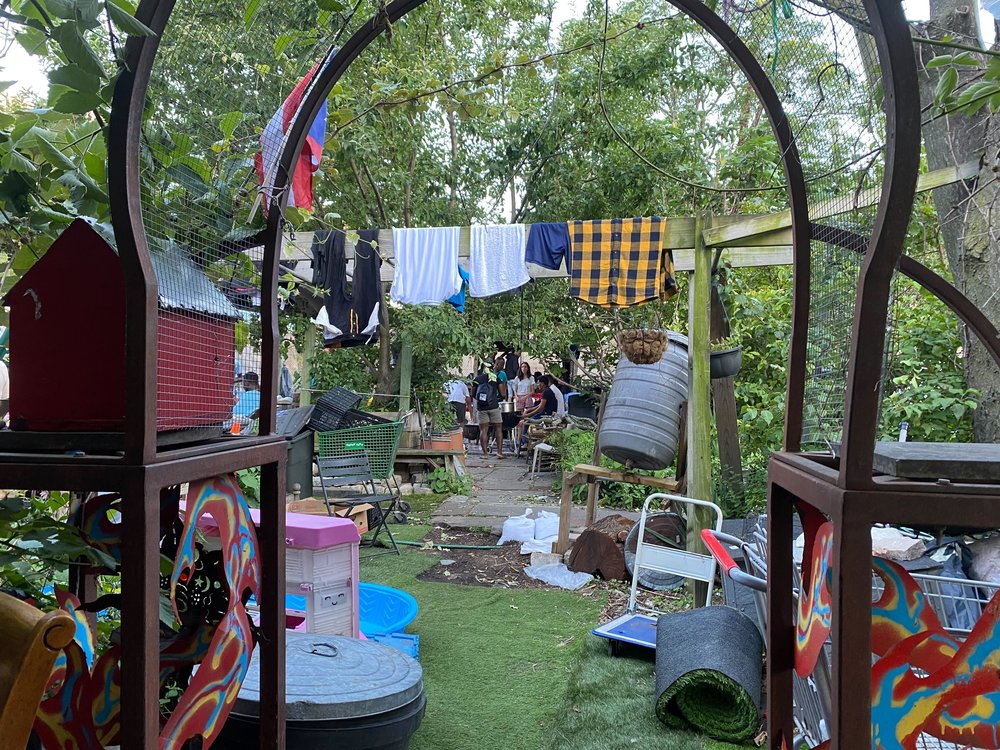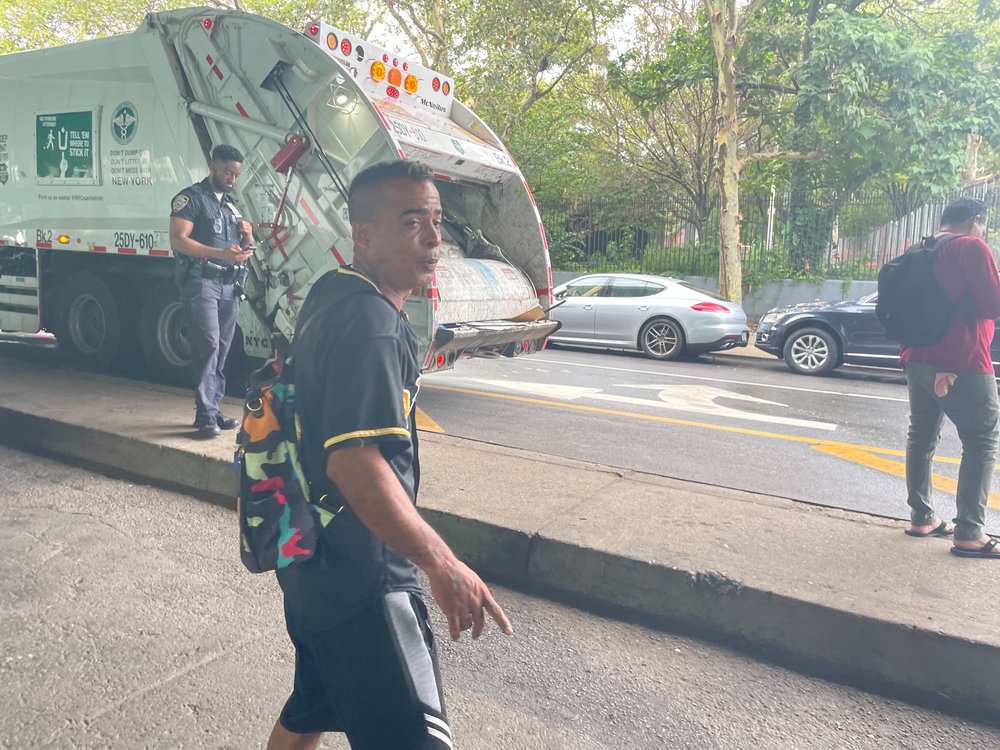For migrants in NY, stays in some city shelters have hit rock bottom, advocates say
July 25, 2023, 4:44 p.m.
One community volunteer charges the city is purposely dropping the ball to discourage migrants both from staying in New York or even coming.

A Bushwick “respite center” serving over 300 adult male asylum seekers went without working showers for weeks, before the scarcity was addressed.
An Upper West Side shelter housing migrant families went without baby formula and wipes for two weeks, until a councilmember intervened.
Migrants staying at a shelter in Queens complain of enduring the summer heat without air conditioning, and being threatened with retaliation for speaking out.
These are just some of the reported issues — along with complaints of insufficient bathroom facilities, undercooked meals and acts of intimidation by facility staff — that have confounded the city’s shelter system for newly arrived migrants in recent weeks.
While there is no reliable accounting of the problems citywide, housing and immigrant rights advocates, joined by some city councilmembers, tell Gothamist the conditions at some sites are deplorable, the city’s offerings are becoming more uneven, and it has become increasingly difficult to ensure the migrants’ basic needs are met.
They are horrific conditions, very inhumane.
Power Malu, from the aid group Artists Athletes Activists
“There are so many fires going on,” said Michael Whitesides, staffer to Councilmember Shahana Hanif, who chairs the Council's immigration committee. “Until someone raises a really big red flag...It adds to the ever-growing list of problems.”
Conditions have become so bad, one aid worker charged that the city has intentionally fallen short, to discourage migrants from staying in New York – or even coming in the first place.
“They are horrific conditions, very inhumane,” said Power Malu from the aid group Artists Athletes Activists. Migrants are “made to feel uncomfortable.” He later added: “I think that (the poor treatment) started in the last couple of months have been done purposely.”
Spokespeople for City Hall did not immediately respond to requests for comment or answer an emailed list of questions about specific concerns raised by migrants and immigrant advocates. After this article was published, spokesperson Kate Smart issued a statement:
"For over a year, New York City has, essentially on its own, provided shelter and support to over 93,200 asylum seekers who have come through our intake system. Our teams worry about capacity and the ability to place people every single day and we do our best to provide for those arriving but it’s been clear for months that we need a national response and more support to address this national issue."

Last week, Mayor Eric Adams announced that the city was out of shelter space, that single adult migrants would be limited to 60-day shelter stays, to free up space for other migrants, and that migrants at the southern border were being discouraged from coming to New York.
To provide for over 54,000 migrants – a sum greater than the populations of Binghamton or Poughkeepsie – the city has scrambled in the last year to set up some 200 facilities, against the backdrop of a housing shortage in New York estimated at some 800,000 units even before the migrants began arriving in large numbers more than a year ago.
While some elected officials acknowledge the daunting challenge and say the Adams administration has promptly addressed problems as they arise, critics say conditions at a number of facilities are so inadequate they are beyond the pale.
Many complaints center on the so-called “respite centers” the administration established in recent months. The sites, as the city first described them, were envisioned for stays of up to a few days at most, in contrast with the city’s “humanitarian relief centers,” which have housed new arrivals for months-long stays. In practice, however, the respite centers have housed migrants for much longer than anticipated, in facilities lacking basic amenities.

One respite center in an old judo gym in Astoria had three showers for nearly 300 migrants, according to a City Council Oversight and Investigations Division inspection report obtained by Gothamist. For comparison, when the city last year erected a tent city on Randall's Island, it included 88 bathrooms and showers for 500 to 1,000 migrants.
“In my household, when six of us were sharing one bathroom, we were getting into fights,” Hanif said. “This is the bare minimum that they're doing.”
She added: “The bottom line is that there’s clear violation of the city’s right-to-shelter decree,” referencing the city’s decades-old court order to provide shelter that meets certain minimum conditions.
Other advocates pointed to what they considered a lack of oversight and formal system for the redress of concerns. Occupants of shelters under the purview of the Department of Homeless Services may submit a formal complaint form to shelter directors or case workers. But Malu said DHS shelters often lack the necessary case workers for migrants to file complaints.
“They [the migrants] have nobody to actually share their complaints with, other than a security guard,” Malu said. “A lot of times, they don’t speak the language, so they don’t ever get their concerns addressed.”
He said when he flags problems via email to DHS contacts, he receives a general “PR response.”
Government interventions
Getting problems addressed can take some doing.
When Gothamist reported over two weeks ago on the lack of showers at a respite center on Stockton Street in Bushwick that was serving hundreds of migrant men, a City Hall spokesperson said the city was hoping to have a portable shower trailer up and running “in a few days.”
The issue had still not been resolved by July 19, when a City Council Oversight and Investigations Division inspection found the center demanded “IMMEDIATE ACTION” due to “NO showers” and “inadequate bathroom facilities.” Migrants were being directed to use showers at public pools, where they initially were denied due to various parks department rules.
By the end of the week, a portable shower trailer was turned on at the site. But lack of showers wasn’t the only concern on Stockton Street.
Jon Caceres, a member of South Bronx Mutual Aid, said he’d heard “dozens of complaints” from residents, including a severe lack of showers, lack of laundry facilities, and lights being left on all night.

“And these aren’t night lights, but super bright industrial ceiling lights that are keeping the men from sleeping,” said Caceres in a text message. “I’ve had folks tell me they’ve preferred to sleep outside because at least it’s dark.”
Elsewhere, Councilmember Gale Brewer’s staff intervened to address a lack of baby formula and wipes at the Riverside Terrace shelter in the Upper West Side, seeing to it that supplies were delivered – after residents went two weeks without.
“It was only delivered because a staff member of mine was there,” Brewer said. “If we heard about it, and we’re not there every day, how did a [Department of Homeless Services] staff member not know?”
Brewer added that DHS staff have been “stretched” and need more resources to oversee the record-high shelter population.
Allegations of retaliation
Murad Awawdeh, the executive director of the New York Immigration Coalition, said it was “quite distressing” to hear newly arrived immigrants struggle to secure food, showers or access to bathrooms.
The city has spent over $1 billion so far to shelter and care for migrants – and the total tab is expected to climb to over $4 billion in the next two years. Several different agencies are pitching in to help, and the city has entered into over 80 contracts with dozens of different vendors, according to a comptroller’s report from March.
“It's just an all-round unfortunate situation to find ourselves in,” Awawdeh said. “And the city needs to hold its vendors accountable to ensure that they're providing adequate space, accommodations and food to everyone who's in their care.”
Meanwhile, the residents of a shelter in a former hangar at John F. Kennedy airport have their own complaints, said Ariadna Phillips, a member of South Bronx Mutual Aid. She received a note from one resident who said that of 34 showers “only five or six” remain working.
The complaint stated that breakfast and lunch “arrive frozen.” Additionally, amid the recent heat, the air conditioning is turned on “only on the side where the administrative staff is.”
Phillips said more than one JFK migrant has complained of being retaliated against for speaking out. Other advocates, along with some migrants themselves, have charged the same.

"They said (shelter staff) they are going to do all they can possible to kick [them] out from the shelter, from the country, because we don't deserve to stay here,” said Richard, a 54-year-old migrant from Venezuela staying at the Stockton Street facility in Bushwick, who asked that his name not be used because he fears retaliation for speaking out.
Richard said he and fellow residents were threatened with retribution for complaining about conditions there. Richard said the Stockton staff ultimately had some of the men removed from the site – some of them ended up in a short-lived tent encampment under the Brooklyn-Queens Expressway in Brooklyn.
Meanwhile, migrants who have run into difficulty have had occasion to raise issues directly with with Mayor Adams.
Weeks ago, a group of migrants – all men – were asked to leave a Clinton Hill shelter. Some 15 helped set up the makeshift encampment under the BQE. A City Hall spokesperson said the migrants violated shelter rules, while the men complained of cramped, unsafe and unsanitary conditions at the Hall Street shelter they left behind.
On Friday, city officials tore down their tents and threw away some of their belongings as part of a homeless camp sweep. And this past weekend, Adams spoke to the men, according to a photo from the mayor’s Instagram.
“After they promised to follow all shelter rules going forward, we spoke with our team and these men are going back into shelter,” according to the caption.
But days later, many of the men remain in the same parking lot under the BQE. Some of the men told Gothamist the other shelter sites they were offered placement were even worse than the Clinton Hill site.
“I’m still here, under the bridge.” Jose Alvarado, 41, said in a voice memo on Monday. “The fight goes on.”
This article was updated with comment from the Adams administration.
Migrants' budding tent encampment under the BQE in Brooklyn dismantled by city officials For some migrants in NYC, a tent encampment under the BQE is now home Faith leaders decry Mayor Adams' sweeps of homeless encampments